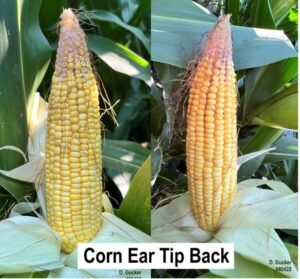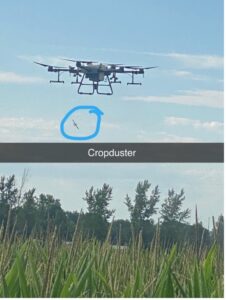Nick Seiter, Field Crops Entomology Extension Specialist
Recent heavy rains should help to slow down or stop pockets of spider mites in soybean in drought-stressed areas. A colleague in Texas reported very large fall armyworm flights a couple of weeks ago; we will watch populations to our south through the rest of the summer to provide a heads up if they make it this far.
Emerson Nafziger, Agronomy Extension Specialist, professor emeritus
Welcome rain this week will help boost yield prospects in some of the drier areas of Illinois, while too much rain in some areas may do the opposite. Where water stands for more than a few days, root function and yields may start to decline. We expect that kernel numbers have been lowered in some of the driest areas, but improved soil moisture will help fertilized kernels to develop to maturity. Soybeans in drier areas have been setting pods over the past week, and pod numbers should recover before stem growth and pod-setting wind down in most fields over the next week.
Nathan Johanning, Commercial Agriculture Extension Educator, Southwest IL
Most of our area now has gotten a break from the drought conditions if they had not in the week prior. We had over 2″ of rain Wednesday night which was very welcomed. I have had many reports of voles in double crop soybean. Many are seeing bare spots in soybean fields where voles have been foraging. With the rain, crops are looking much better, but you can still see some shorter plants from the stress earlier in the season. It will be interesting to see how much the plants can recover any yield potentially lost.
Doug Gucker, Local Foods Small Farms Extension Educator, Central IL
Much needed rainfall came to this part of the state over the past 7 days with totals varying from 0.75 – 5+ inches. Corn is in the late R3 to early R4 stage and ears do not seem to be filled to the tip due to heat and drought. Soybeans are in the R4 stage and still blooming.

Corn ear tip back is common due to hot, dry weather.
Chelsea Harbach, Commercial Agriculture Extension Educator, Northwest IL
What a roller coaster ride we’ve been on this summer! I feel like each week I’m saying something different with regards to the disease outlook, as the weather has been shockingly unpredictable and keeps throwing me for loops. Planes have been flying for the fourth consecutive week. I think that we’ve only just reached the point where diseases are actually a viable concern for finishing out the crop. Remember, fungicide activity of leaf surface is around just two weeks. Keep that in mind as we move into what appears to be a period of weather that looks more conducive to disease development.
Weston Olson, ILSoyAdvisor Soy Envoy
Crops continue to look excellent with little changing to yellow from stress on even the sandy parts of our fields. The area is getting a bit dry, but this is August and we have had timely rains the past few Augusts so keeping our fingers crossed. Beans are R4 and putting on full pods from top to bottom and still flowering. Corn is filling the ears nicely and not seeing much disease damage. Waterhemp has made it through our 30-inch soybeans rows so that is not ideal.
Brad Zimmerman, ILSoyAdvisor Soy Envoy
Busy week in agriculture with some rains coming through in Tazewell County. Lots of growers pushing to apply fungicide and some are adding insecticide to combat stink bugs. Little insect pressure but for growers that have seed beans, the quality is key. We have been busy with the drone spraying fields that are not easily accessible by plane or cannot be reached with a ground rig.





 and then
and then